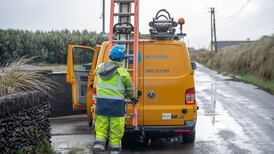Employment growth in the Irish economy is continuing to accelerate with official figures indicating that nearly 20,000 jobs were created in the first three months of the year.
The positive trend is being driven by a rapid pick-up in employment in the technology and construction sectors.
According to the latest Quarterly National Household Survey (QNHS), there was an annual increase in employment of 3.5 per cent or 68,600 in the first quarter of 2017, bringing total employment to 2.04 million.
This was, however, still below the State’s peak employment level of 2.16 million, recorded in the first quarter of 2008.
On a quarterly basis, employment grew by 19,300 in the first quarter of this year which was the fastest rate of growth in nearly four years. It also follows increases of 16,800 and 14,600 in the previous two quarters.
The survey, which is considered the most accurate barometer of conditions in the labour market, shows that employment increased in 11 of the 14 sectors reviewed by the series.
Unemployment
The largest rates of annual increase were recorded in the information and communication sector, which saw employment rise by 7,500 or 8.8 per cent; and the construction sector, where employment rose by 8.5 per cent or 11,100.
However, there were falls in employment in three sectors with the biggest decline coming in agriculture, forestry and fishing (-1,600), which one analyst linked to Brexit .
The QNHS also showed there were 146,200 people classified as unemployed in the State in the first quarter of 2017, following an annual decrease 33,200 or 18.5 per cent.
As a result, the Republic’s headline rate of unemployment for April was put at 6.4 per cent, which represents a slight upward revision on the monthly series.
Having had one of the highest rates of unemployment in Europe only a few years ago, the Republic's jobless rate is now significantly below the euro area average of 9.5 per cent.
Analysts are predicting unemployment will fall to below 6 per cent before the end of the year.
Improving conditions in the labour market has turned the tide on emigration, which had been a feature of the early part of the financial crisis, with the most recent population figures indicating the State was now experiencing net inward migration.
Minister for Finance Michael Noonan said the latest employment numbers demonstrated that economic growth was generating significant dividends in the labour market.
“The policies that have been implemented by the Government continue to bear fruit. The objective in the months and years ahead is to enhance the resilience of the economy in order to protect these gains and generate more jobs in the future,” he said.
Employers’ group Ibec welcomed what it described as “exceptionally strong jobs numbers”, suggesting they were a sign of the strength and substance behind the State’s business model, while noting that the economy was weathering Brexit uncertainty “very well”.
It said worries that weaker-than-expected income tax receipts signalled a slowdown in employment growth would be assuaged by the latest numbers.
Merrion analyst Alan McQuaid said: “Although emigration has been a factor to some degree in keeping unemployment down since the financial crisis, the labour market has improved dramatically over the few years, reflecting the strengthening of the economic recovery.”
“ Indeed, the most recent migration estimates showed net inward migration of 3,100 in the year to April 2016 as against net outward migration of 11,600 in 2015, and the first positive figure since 2009,” he said.












